
- Source: BOMB Magazine
- Author: Brian Chidester
- Date: January 23, 2014
- Format: Online
Raul De Nieves by Brian Chidester
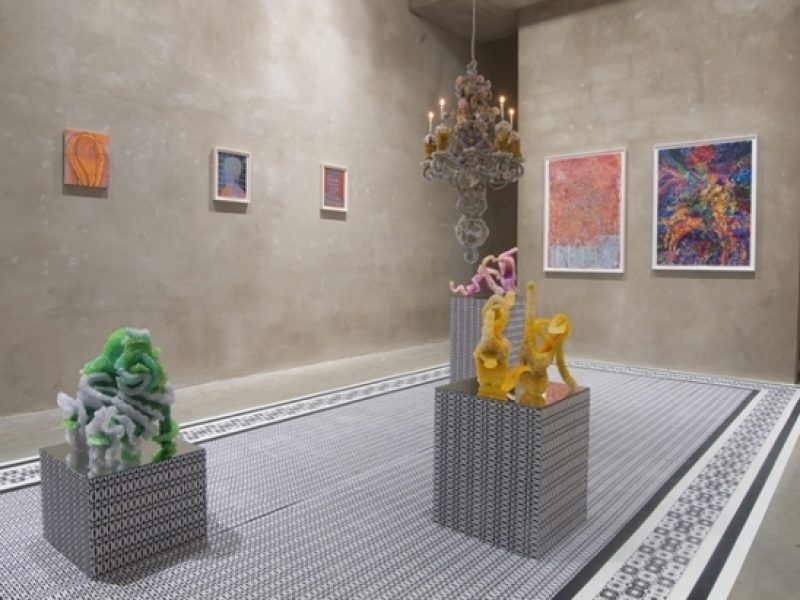
Raul De Nieves, The Reveal. All Images courtesy of the Loyal Gallery Malmo.
On a recent evening this past October, I dropped by Secret Project Robot, an artists collective in Bushwick, which I’ve covered numerous times for the Village Voice. There I found Raul de Nieves in the back, busily plotting his latest exhibition, which opens November 9th at SPR. Amidst an array of wildly enchanting, multi-hued content, di Nieves took a break to discuss his many inspirations. Not surprisingly, the artist laced his responses with a candid mix of autobiographical, political and deeply spiritual insights that shed new light on his series of paintings that re-tell the saga of St. George, as well as the vine-like beaded shoes that have become his trademark as a sculptor.
Brian Chidester
So the thing that struck me about your painted works—and perhaps we should begin there—is the overwhelming, almost religious passion they inspire. Where did this spiritual way of seeing the world come from?
Raul de Nieves
For sure from Mexico when I was a young child. There are so many legends about saints and old spirits that I was introduced to there. Looking at the structures and how people worshiped these images really gave me a great understanding of how people connect with images in general.
BC
That’s interesting, because while there’s an almost folkloric quality to the compositions, they also have an obsessive fury in the way they fracture their subjects. It’s like by the very act of physically applying paint, you feel like you can access the spirit realm.
RDN
My spirit is very free. I wake up and listen to a chant that I found at the end of the year—“Om mani padme hum.” It gives me the ability to think of a higher power, which is my mind. Most of the time I’m thinking and sometimes it has nothing to do with spirituality. But I try to find the inner demons that give my thoughts pleasure. Like my dreams, for instance. I can see my work in my sleep; it’s usually at the beach, calm but surreal. Then the chant allows me to not think at all. Then when I paint I try to let time slide, to almost forget. That’s why I choose a repetitive practice— to just sit and stare, almost machine-like.
BC
I feel like in this most recent series of paintings there is a distinct figurative motif. And yet it sounds like you are surprised by where they go.
RDN
When I start a work, that is when most of the thinking happens. A story is definitely being told and the figure is the core. But as the painting grows, I try to hide it.
BC
Oh, okay. So there is a story and a figure? Can you tell me about it?
RDN
It’s Saint George in all four of the large works. I started getting obsessed with the story in a smaller series of paintings a while back. I want to think of them as stained glass windows. Like a window to another world. Looking at stained glass windows in churches, you see color and design first. But if you look closely, there’s always a story to unlock. The story of Saint George talks about defeat and the idea of giving up. A city once stood strong, until one day a giant dragon appeared and inhabited the city’s water supply, demanding the people bring it their goods. People did so every day because they needed water in return. It started with fruits and vegetables, then came the animals. This happened daily, until most of the city’s goods started to disappear. Eventually, a lottery system was made up so that people had to become victims of their own making. The dragon’s last victim was the princess. Every one wanted this to stop, but they had no idea how to defeat a monster until one brave soul stood up and fought the dragon and brought it back to the town to show that with courage anything is possible. I see that in my mom and how she fought so many situations to make her life better, not so much for herself, but for us.
BC
Where are you from originally?
RDN
Morelia, Michoacan. I moved to San Diego when I was nine. Backing up, at the age of two, my father passed away and left my mom with three of us and I remember seeing her struggle to make sure we got our daily feed. She worked three jobs, so we got to spend little time with her. Even when we moved to California, she never stopped working. So she’s the Saint George of my life. She taught me to be the best at what I do with my mind and hands. She always expressed the craftsmanship of the human. In school in Mexico we learned how to cook, knit, embroider, tailor. That’s where the love of labor comes from in my work.
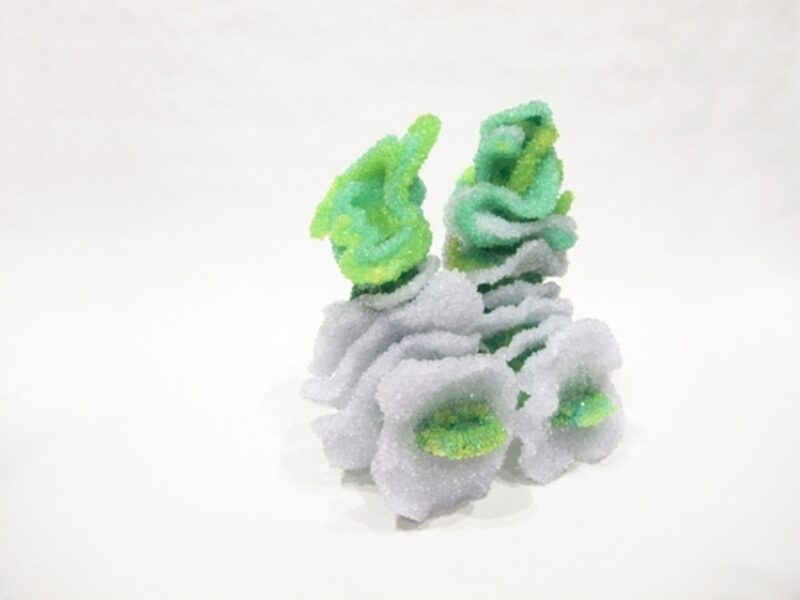
Raul De Nieves, Eleven Blooms.
BC
Is there also something of Saint George that you relate to in yourself?
RDN
I’m both Saint George and the dragon. I’m all of it—the city, the people. We have to think of ourselves as everything. I fight myself in many ways. Having an artistic practice allows me to get in touch the real me. The ability to experiment, to bend the rules . . . I feel like it saves me.
BC
Let’s talk about this notion of everything. You say you are everyone in the Saint George saga.
RDN
I think most of the time I relate more to the dragon and the city. I guess it’s the victim of reality concept and how we have to sometimes sacrifice to be human. The dragon represents the vice inside of me. The city feeds me. The paint and paper is Saint George. It’s what calms me, gives me the ability to see. I can see courage in the everyday. In our world we are told to choose an identity, go to school, get a job. I want the lines of identity to fade. Gender identity, for instance, is what we are told we have to choose.
BC
So then the different sides of Raul come out in different ways with each one?
RDN
Yes. Though sometimes I get super frustrated and want to tear them apart, see it go away.
BC
I hope you don’t.
RDN
No. But I have done that to sculptures and older works. I feel like I want to erase them as soon as I’m done. When I was young I was very depressed. I’ve always felt almost alone.
BC
The world can be a very dark and violent place sometimes and it’s rare to see people like yourself, Raul. Even in NYC, I think with the gothic rings and the heavy, ornate chains you wear and the polka dot pants, long hair and women’s high heels, you sort of exude eccentricity and artiness, so much so that I’m sure just walking out the door is something of a brave act for you.
RDN
I feel that.
BC
It’s amazing. We have our bodies with which to express all of these survival mechanisms. Your body can fight disease, it can take you places, it carries all of who you are on the inside and expresses that on the exterior.
RDN
I’ve seen my body in all situations, even in hell. The people around me, friends dying. My childhood was really crazy. Seeing my dad die so young. Coming to America and seeing my mom have everything taken away from her. It put all these things into reality.
BC
Maybe this is a good time to segue into the work you’ve done with shoes. I mean, there is something very fetishistic about them and fetish has a kind of taboo quality to it. In fact, you told me the first pair of shoes that “became” sculpture were actually just an old smelly pair that were so tattered that they literally took on an arty quality and someone bought them!
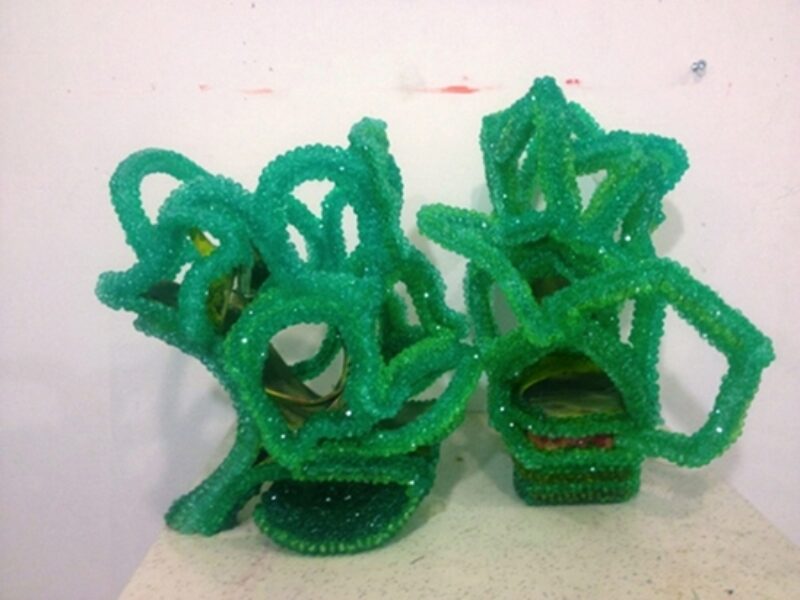
Raul De Nieves, Green.
RDN
Shoes make me feel my body in ways . . . especially when I wear high heels. You feel every part of the body in how they make you walk. I guess I choose shoes as a vehicle to adorn myself, to give off different identities. I love adornment and don’t want to limit myself. Wearing girl’s clothes to me is not about bending rules. I wear what I like. It was the first way I could express individuality. Clothes make you a character in ways and shoes have always classified people. It’s not so important to be a character. We just become them, in ways. That’s why I think I can be the dragon in the story, at times, like with how we all feed the system.
BC
I can see that. What’s most inspiring, especially now hearing your story, is the powerful lack of pessimism in your work, especially the shoes. They’re so enchanting.
RDN
I’ve learned that we have to find our own saviors. For me, I like to create a fantasy and one of the ways I’ve found beauty is by stacking beads on top of each other. I usually work in circles and let time shape the work.
BC
What’s great about the shoes is that, instead of making a simple craft with some inherently folky order, you’ve managed to break open shoemaking so that the vines or tentacles that come off of the shoes feel like they literally can flow anywhere.
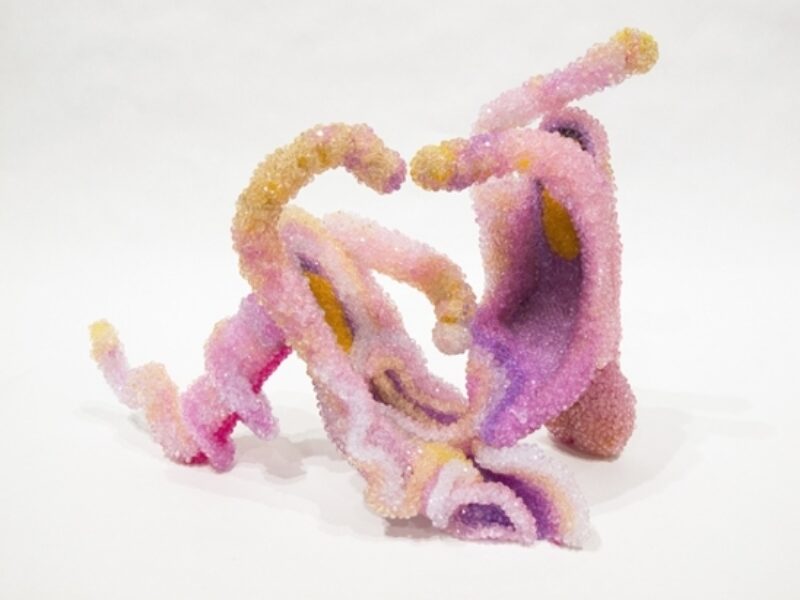
Raul De Nieves, Pena and Jo (The Art of Comfort).
RDN
The shoes are very organic. I actually see them grow. It pushes me to want to learn more about weight and design, to push them into new forms. But I also want them to design themselves in a way.
BC
Why use beads? I mean, beads have mass. Yet you’ve managed to see them not as hard shells that conform to a certain line, but rather as these materials that you can bend at will. That strikes me as a strange way to deal with hard plastic materials.
RDN
They act like bacteria. Most people use beads in very traditional ways. I like to think of them as dots. They feel fluid to me. It’s almost like a craving.
BC
Earlier you talked about the fantasy aspect of the shoes. Which made me think of, on the one hand, Mexican beadwork and crafts. But they also make me think of Dorothy’s ruby slippers in the Wizard of Oz.
RDN
Right. Her shoes take her on a journey. Without them she’s lost. At the end, she always knew that they could have taken her home. But that’s what shoes do. I mean, when I wear shoes for a long time, each one ends up looking different. One might have holes or more wear on the heel. So they show how each foot has its own ways. That’s kind of why I create them as relics. To encase the shoe in this frozen form where no one can wear them again.
BC
Interesting that you see them as relics. They then become commemorative?
RDN
They have. And seeing them go into different worlds after they are done is interesting too. Now the fashion world sees them as an objects of desire. The shoes are a performance in their own right. They’ve been photographed by Karl Lagerfeld and put in magazines like Harper’s Bazaar. Models wear them. It’s kind of funny. They make their own stories.
BC
I know you also do crocheting and beadwork on things like hanging lamps. Yet these seem to have that same feel as the shoes in a way. What I mean is, for instance, knitted yarn is kind of functional material. One makes blankets or knits hats and scarves, right? But yours are again more obtusely-shaped and organic-looking. How does that type of work differ from the shoes and the paintings? And how are they the same?
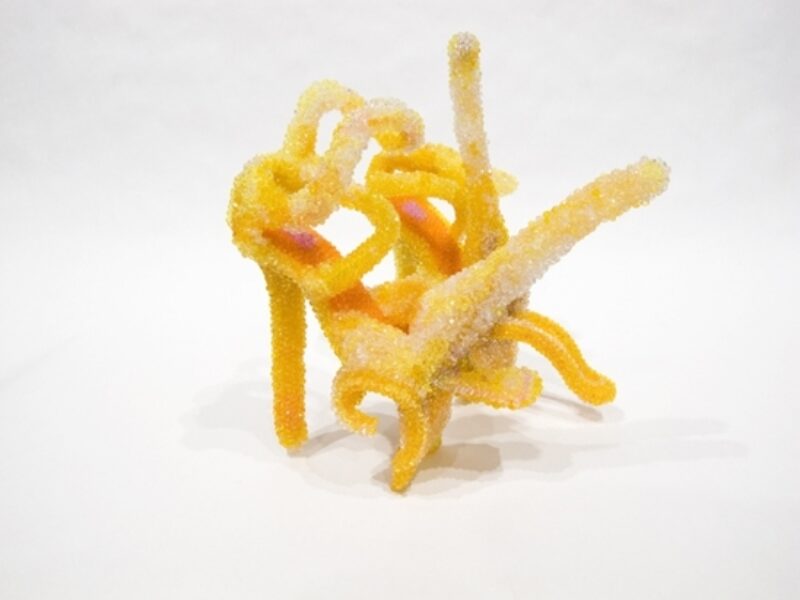
Raul De Nieves, Ton Guis.
RDN
I think everything comes from the same place because it’s all manual. Crocheting is the most simple, but I feel that everything is organic and that’s why it all fits into the same world. Even my new oil paintings are done by squeezing the paint to look like string on the canvas.
BC
You like to change the function of materials.
RDN
Yeah. I guess I see the bravery in me in that light. The work really is a mirror of me, the investigations I seek and how they can be shared with others. My work is a pure reality of me.

